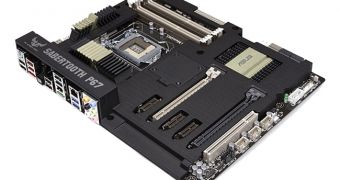Some might know of the high-end motherboard that ASUS launched last year for the Sandy Bridge series of central processing units, but it looks like its primary unique feature might do more harm than good.
All motherboards of today have some measure of cooling prowess, since all those chips, capacitors and other heat-generating components need some way to cool off.
Granted, the heat in a system is, primarily, generated by the CPU and the graphics card, and even the RAM (random access memory).
Still, high-grade platforms have their heatsinks, and ASUS could very well be said to have taken things up to eleven when it built the Sabertooth P67.
Simply put, the motherboard has what its maker dubbed “Tactical Jacket” at first and renamed to “Thermal Armor” later, that being a shroud that covers the product more or less entirely.
Now, The Tech Report discovered that said product actually could do better without that cover, since it actually drives temperatures up instead of down, at least for PCs running heavy workloads.
More specifically, when a system is running CPU-intensive and graphically-heavy programs, the temperature rises by up to ten degrees Celsius compared to one whose Sabertooth P67 does not wear the shroud.
Had the coat been supplemented by a cooling fan, this standout feature would have likely turned out to be the advantage it was supposed to be.
Unfortunately, adding a cooling fan on any region of the mainboard is a quick ticket to interfering with the installation of AIBs (add-in-boards) and, depending on the size of the case and placement of the spinner, storage drives.
For those that want a reminder, the platform has two PCI Express 2.0 slots, four memory slots and all expected connectivity and I/O, including two USB 3.0. It remains to be seen whether or not ASUS revises the concept with a shroud that works.

 14 DAY TRIAL //
14 DAY TRIAL //